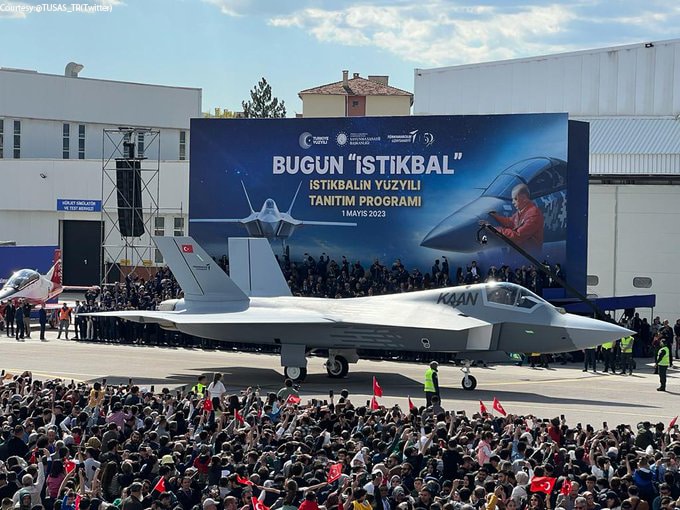Aviation
Ukraine enters a tender for the engine development for Turkey’s KAAN Fighter.

In the competition to create the initial engine for the KAAN fighter plane, the Ukrainian business Ivchenko Progress also took part. The National Combat Aircraft (MMU) Project will include the development of a national turbofan engine for the KAAN warplane by the Presidency of Defence Industries. The “Preliminary Design Phase Project” was recently initiated in this area.
According to data gathered by SavunmaSanayiST.com from defence sources, TRMotor’s principal contractor submitted the tender for the preliminary design phase project, which was started by the SSB as part of the MMU Original Engine Development Programme, under the cooperation model of TEI and Ivchenko Progress.
Engines from Ukraine are utilised in aircraft and ammunition such as the AKINCI T? HA, KIZILELMA, ANKA-3, KEMANKES, and Super??M? EK, which was developed by the Turkish defence industry. The T929 Heavy Class Attack Helicopter, however, also makes use of a Ukrainian-supplied engine.
On the other side, the Turkish Kale Group company and the British Rolls-Royce company had partnered to develop the engine for the National Combat Aircraft. In the same tender, TAEC is a competitor. With Kale Holding A., Rolls Royce Overseas Holdings Limited, and TAEC Aircraft Engine Industry Inc., the company was founded in 2017. The company is 51% owned by Kale Group.
The Kale Group company, Kale Arge, is renowned for creating the first turbojet missile engines in Turkey.
The SOM and ATMACA missiles will be powered by the Kale Arge KTJ-3200 and KTJ-1750 turbojet engines; AKIR. In contrast, the business provides the KTJ-3700 for the LAND SHOOTER and GEZG? N is working on the Cruise Missile’s engines as part of the ARAT Project. The Roketsan AKIR Cruise Missile’s first fire test with the KTJ-1750 Turbojet Engine just ended successfully.
According to Prof. Dr. Ismail Demir, president of the defence industry, the creation of a national turbofan engine for the KAAN fighter aircraft could take somewhere between 8 and 10 years. Currently, the KAAN fighter aircraft uses the US-made F110 Turbofan Engine. An F110 engine will power the first 20 KAAN aeroplanes, which are anticipated to fly for the first time in 2023 or 2024.
The Turkish Air Force is expected to receive the first KAAN from TAI in 2028.

Aviation
Boeing, Antonov to Collaborate on Defense Projects

– MOU represents Boeing’s commitment to work with Ukrainian industry
– Includes exploring opportunities for collaborating on in-country support of Unmanned Aerial Systems
A Memorandum of Understanding was signed today by Boeing and Antonov Company to investigate potential collaboration on defense-related projects.
“We’re happy to keep collaborating with the Antonov Company to help Ukraine’s economic development and expansion,” stated Ted Colbert, CEO and president of Boeing Defence, Space, & Security.
Airbus and the Antonov An-225: The Best Partnership:Click here
“This agreement demonstrates our ongoing efforts to find more opportunities to work with Ukrainian industry, which was underscored by our signing of the Ukrainian Defence Industry Compact earlier this year.”
The areas of potential collaboration identified in the agreement consist of training, logistical support and overhaul services for tactical Unmanned Aerial Systems utilized by the Ukrainian Armed Forces, which includes the ScanEagle. In addition, the companies will also explore opportunities for Antonov to provide engineering support to Boeing.
The six largest cargo aircraft ever built in the aviation industry:Click here
“A strong, innovative, and efficient defense industry is key to sustainable economic development and national security, and we are extremely excited to collaborate with Boeing,” said Ievhen Gavrylov, CEO of Antonov Company.
This agreement brings a whole new level of opportunity to implement the latest and most effective solutions – in addition to the possibility of future projects with Boeing in the aerospace and defense industry.”
-

 Travel1 week ago
Travel1 week agoAir India to Expand US Operations with Three New Routes After a Decade
-

 Travel2 weeks ago
Travel2 weeks agoWhy We Should Avoid These Stamps in a Passport
-

 Airlines1 month ago
Airlines1 month agoInvestigations Reveal Fake Chinese Titanium in Boeing and Airbus Jets
-

 Tech4 weeks ago
Tech4 weeks agoChina’s CATL Plans 1,800-Mile Electric Plane Launch by 2027
-

 Airport3 days ago
Airport3 days agoTop 10 Largest Airports in the World by Size
-

 Aerospace4 weeks ago
Aerospace4 weeks agoChina’s Fighter Jets Turn Wings into Autonomous Drones
-

 Airlines4 days ago
Airlines4 days agoAir India Rolls Out A350s for Delhi-New York JFK and Newark Routes
-

 Defence3 weeks ago
Defence3 weeks agoBoeing Enhances Chinook with New Engines and Block II Upgrades at $96 Million







